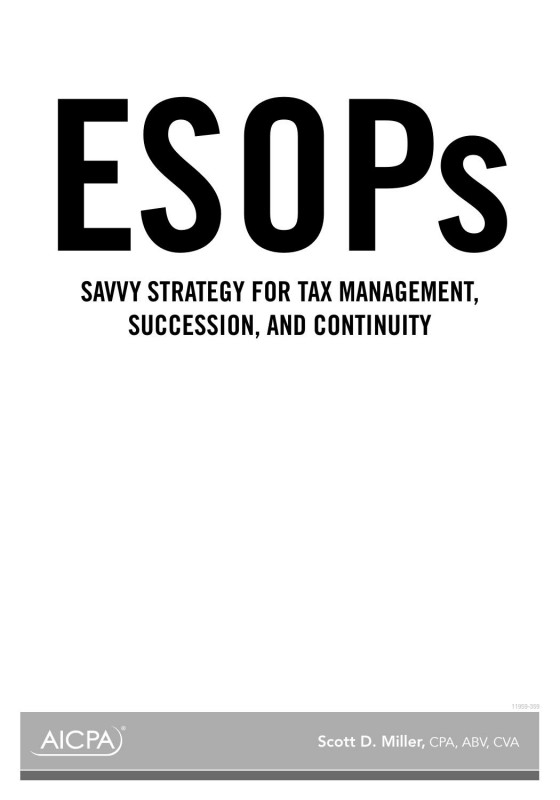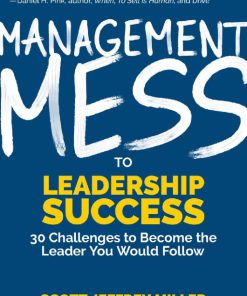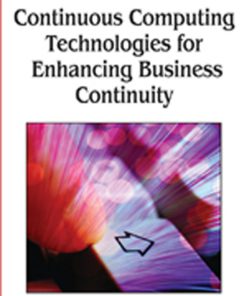ESOPs SAVVY STRATEGY FOR TAX MANAGEMENT SUCCESSION AND CONTINUITY 1st Edition by Scott Miller ISBN 1937350541 9781937350543
$50.00 Original price was: $50.00.$25.00Current price is: $25.00.
Authors:MILLER, SCOTT D , Series:Management [828] , Author sort:MILLER, SCOTT D , Languages:Languages:eng , Publisher:AICPA
ESOPs SAVVY STRATEGY FOR TAX MANAGEMENT SUCCESSION AND CONTINUITY 1st Edition by Scott Miller – Ebook PDF Instant Download/Delivery. 1937350541 ,9781937350543
Full download ESOPs SAVVY STRATEGY FOR TAX MANAGEMENT SUCCESSION AND CONTINUITY 1st Edition after payment
Product details:
ISBN 10: 1937350541
ISBN 13: 9781937350543
Author: Scott Miller
Changing demographics, impending changes in taxation, and challenging economic conditions have made ESOPs a creative strategy to ensure organization survival and success. This publication defines issues that must be fully considered before installing an ESOP, and highlights the common attributes of successful installations. Use this book to chart a course through succession issues and transition ownership issues with a minimum impact to financial results. The book offers you practical strategies to deal with current economic realities and taxation challenges, including the following:
- Increasing tax rates in the near future will make ESOPs a tax efficient option for business owners.
- In recessionary times ESOPs control the succession process versus letting probate and inheritance taxes jeopardize the survival of their organization.
- Financing for almost any business transaction is difficult; ESOPs are very seller finance friendly.
ESOPs represent an effective exit vehicle for Baby Boomer owners.
ESOPs SAVVY STRATEGY FOR TAX MANAGEMENT SUCCESSION AND CONTINUITY 1st Edition Table of contents:
Chapter 1: Introduction to ESOPs
- What is an ESOP?
- The Basics of Employee Stock Ownership Plans
- How ESOPs Work: The Structure and Benefits
- ESOPs vs. Other Ownership Models (e.g., private equity, public offerings)
- The History and Evolution of ESOPs
Chapter 2: The Strategic Role of ESOPs in Business Succession
- The Need for Succession Planning
- How ESOPs Facilitate Smooth Transitions
- ESOPs as a Tool for Preserving Legacy and Values
- The Impact of ESOPs on Family-Owned Businesses
- Managing Employee Expectations and Engagement in Succession
Chapter 3: ESOPs and Tax Management
- The Tax Advantages of ESOPs for Employers
- How ESOPs Can Help Maximize Tax Deductions
- The Role of ESOPs in Deferring Capital Gains Taxes
- Understanding ESOP Taxation for Sellers
- State and Local Tax Considerations
- Structuring an ESOP for Optimal Tax Efficiency
Chapter 4: The Process of Establishing an ESOP
- Step-by-Step Guide to Setting Up an ESOP
- Understanding the ESOP Plan Document and Fiduciary Duties
- Appraising Company Value and Employee Shares
- Funding the ESOP: Leveraged vs. Non-Leveraged Transactions
- Legal, Regulatory, and Compliance Considerations
- Common Challenges in Setting Up an ESOP
Chapter 5: Financing and Funding an ESOP
- Understanding ESOP Financing Structures
- How to Fund the Purchase of Shares for an ESOP
- Leveraged ESOPs: Pros, Cons, and Considerations
- Alternatives to Traditional Financing: Seller Financing and Other Options
- Managing Debt and Risk in ESOP Transactions
- The Role of Financial Advisors and ESOP Trustees
Chapter 6: Governance and Employee Engagement in ESOP Companies
- The Governance Structure of ESOP Companies
- Employee Involvement in Decision-Making
- Balancing Employee Interests with Business Goals
- The Importance of Effective Communication and Transparency
- Training and Educating Employees About Ownership
- Aligning Corporate Culture with ESOP Goals
Chapter 7: Valuation and the ESOP Process
- Understanding Business Valuation for ESOPs
- How Valuation Affects ESOP Transactions
- Determining the Value of Stock and Employee Share Allocation
- Common Valuation Methods and Their Application in ESOPs
- Engaging Appraisers and Independent Experts
- Addressing Valuation Disputes and Challenges
Chapter 8: ESOPs and Business Continuity
- Ensuring Long-Term Stability with an ESOP
- Using ESOPs to Retain Key Employees and Enhance Motivation
- The Role of ESOPs in Mergers, Acquisitions, and Business Restructuring
- How ESOPs Protect a Business’s Legacy and Ensure Continuity
- The Role of ESOPs in Facilitating Intergenerational Transfers
Chapter 9: Managing the Transition to Employee Ownership
- The Transition Process: What to Expect and How to Manage It
- Overcoming Resistance and Addressing Employee Concerns
- Building a Strong Ownership Culture in the Company
- The Role of ESOP Trustees and Advisors in the Transition
- Case Studies: Successful ESOP Transitions
Chapter 10: The Benefits and Challenges of ESOPs
- Key Benefits for Employers, Employees, and the Company
- Potential Pitfalls and Risks of ESOPs
- How to Address Challenges in ESOP Administration
- Maintaining Company Performance During and After Transition
- Tax Implications for Employees and Owners
- Long-Term Outcomes of ESOP Implementation
Chapter 11: Regulatory and Legal Considerations for ESOPs
- ESOP Compliance with ERISA and IRS Regulations
- Fiduciary Responsibilities of ESOP Trustees and Plan Administrators
- Legal Issues in ESOP Transactions: Disclosure and Reporting Requirements
- How to Avoid Common Legal Pitfalls
- Protecting Employee Interests and Ensuring Fairness
Chapter 12: Case Studies: Real-World Applications of ESOPs
- ESOPs in Small and Family-Owned Businesses
- Large Corporations Using ESOPs for Succession and Growth
- Lessons Learned from Successful ESOP Implementations
- Challenges Faced by Companies Using ESOPs
- Key Takeaways from Various Case Studies
Chapter 13: The Future of ESOPs and Employee Ownership
- Trends in Employee Ownership Models
- The Impact of Changing Laws and Regulations on ESOPs
- The Role of ESOPs in Modern Business Strategy
- How ESOPs Can Contribute to Sustainable Business Practices
- The Potential Growth of Employee Ownership in the Coming Decade
Conclusion: Creating a Legacy Through ESOPs
- Recap of the Key Benefits and Strategies of ESOPs
- Why ESOPs Are an Effective Tool for Tax Management, Succession, and Continuity
- The Importance of Planning Early and Getting Professional Guidance
- Looking Ahead: The Future of Business Succession and Employee Ownership
People also search for ESOPs SAVVY STRATEGY FOR TAX MANAGEMENT SUCCESSION AND CONTINUITY 1st Edition:
tax strategies for the savvy real estate investor
esop strategies
esop taxation rules
tax savvy for small business pdf
You may also like…
eBook PDF












